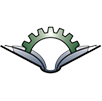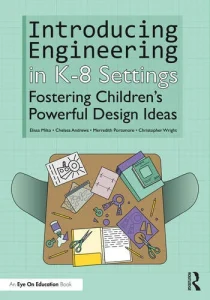
With the Novel Engineering approach, “students become excited about what they are reading, writing, designing, and building! This excitement in turn helps them make strides in engineering and literacy, as well as in their abilities to work together, think creatively and analytically, and communicate their ideas.” — from Chapter 1 of Novel Engineering
This book will both introduce your students to an exciting integrated curriculum and support you as you use it in your own elementary or middle school classroom.
Novel Engineering shows how your students can work through engineering design challenges inspired by a broad range of literature—novels and short stories, biographies and histories, or even picture books. By way of introduction, the book offers clear conceptual background and practical advice on how the approach works: Your students pull information from literature to identify a problem. Then, using details from the story or text, they go through an engineering design process to develop functional solutions for their “clients”—the book’s characters.
To support your efforts and bring the concept to life, the book gives you five in-depth case studies featuring the use of novels, a biography, and a nonfiction historical text. In addition to demonstrating what a Novel Engineering project looks like in an actual classroom, the case studies give you practice in thinking about what your students’ work might look like and how you would respond. One case describes a class in which students help the shipwrecked Swiss Family Robinson build a shelter to keep them cool under the hot sun. Another tells of students who design a hearing aid for the main character in El Deafo—and then style it as a fashion accessory.
You’ll see that the books used in the case studies are just suggestions. You don’t have to adopt texts outside your existing English language arts or social studies curriculum. You also don’t have to buy a specific building-materials kit. You just have to embrace the idea that literacy and engineering can support each other in your classroom—and then watch the excitement build.

Introducing Engineering in K-8 Settings will provide you with the tools you need to incorporate engineering design into your classroom. Rather than prescribing a specific curriculum to follow, this book will help you engage your students with hands-on, open-ended engineering design problems that can be easily integrated into your existing classroom setup.
Beginning with the basics of K-8 engineering, and advancing to topics such as integrating engineering with other disciplines, documentation, and assessments, the chapters provide a how-to on creating open-ended engineering activities, design tasks, and projects that are reflective of the academic, social, emotional, developmental, and community goals of your students. An additional focus is on ways to adapt these pedagogical approaches to meet the needs of all students, representative of racially, ethnically, socioeconomically, and gender diverse populations and students who receive special education services. Case studies and practical implementation strategies are presented alongside more than fifteen lesson plans, with tips on how to modify the tasks presented in the book to work with your classroom and students. This user-centered approach will also help you create your own engineering lessons that meet your individual classroom objectives and interests, and be able to recognize and classify your students’ engineering behaviors to support them in enacting their ideas.
No matter your experience or comfort level, this book will be an invaluable resource for elementary and middle school science and technology teachers at all career stages who are looking to introduce engineering design to their students.
Additional classroom resources can be found online at introducingengineering.org.

